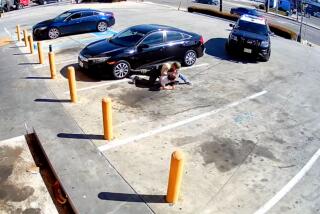L.A. County Civilian Oversight Commission to study Sheriff Department’s use of Tasers

- Share via
Two years after a sheriff’s deputy fired a Taser at a handcuffed man outside his family’s home, the Los Angeles County district attorney’s office declined to file charges because it is unclear if the officer shocked him unintentionally, then lied about it in a report, or if the action was an intentional use of excessive force.
The former charge is a misdemeanor; the latter can be a misdemeanor or a felony.
After reviewing video of the April 2021 incident and witness statements, prosecutors decided they had “insufficient evidence to prove either charge beyond a reasonable doubt,” according to a February memo recently obtained by The Times.
Now, the matter will go back to the Los Angeles County Sheriff’s Department for an internal investigation that could lead to disciplinary action. Adam Marangell, general counsel for the Los Angeles Sheriff’s Professional Assn., said he and his deputy client were pleased that prosecutors “correctly chose to decline this case.”
Yet criminal justice experts say the case illustrates the difficulty of scrutinizing officers’ use of less-lethal weapons, which can be as chaotic and complicated to analyze as that of firearms but typically receives less public attention.
“There are some genuine logistical challenges to figuring out when the officer’s use of a Taser may have been excessive,” said Jacinta Gau, a University of Central Florida criminal justice professor. “But less-lethal force is not routinely or systemically documented in a way that the public can access, evaluate or hold officers accountable for — and the most simple explanation is that, typically, nobody died during it.”
The Sheriff’s Department’s use of one type of less-lethal force, Tasers, is set to come under more scrutiny. In March, the Civilian Oversight Commission put out a call for public input on the issue.
“There’s obviously been some settlements around this area in the last five years,” said commissioner Luis Garcia. “But the thrust of it was just recognizing the use of Tasers as a less-than-lethal practice the Technology Ad Hoc Committee wanted to look at.”
In 2021, the county paid $2 million to the family of a man who died in 2018 after deputies shocked him with a Taser . Last year, the county agreed to pay $3.8 million to the family of a man who died in 2015 in Willowbrook after being shocked by a deputy. A few months later, the county settled for more than $16.2 million after a Maywood man died when he was beaten and tased by deputies responding to a call from his mother, who said he was in the midst of a mental health crisis.
The April 18, 2021, incident detailed in prosecutors’ February memo began when two Lynwood deputies responded to an early-morning call about a family disturbance. The caller said his brother had broken into the home and refused to leave. The alleged intruder — who is not named in the memo — hadn’t lived there for about five years.
The caller said his brother was usually “on drugs and unpredictable.” This time, the caller feared that his brother would assault their elderly grandmother.
The deputies went to the backyard and started calling the man’s name. When they spotted him, they ordered him to come out with his hands up.
He refused, and as the standoff unfolded, two more deputies — John Hunziker and his partner — arrived. Not long after that, the man came out with his hands up but refused to turn around. Three deputies moved in for a “team takedown” while ordering him to stop resisting.
“In a second, in a second,” the man said, according to the memo.
“I’m going to tase you,” Hunziker warned. The man wriggled on the ground and started to kick at another deputy’s legs and lower back, so Hunziker shocked him three times, prosecutors wrote.
The man screamed that he couldn’t breathe and kept kicking. The deputies put him in handcuffs.
“I can’t breathe,” he repeated. “Don’t do that again.”
At that point, the man stopped kicking, but the deputies didn’t remove the Taser prongs from his shirt. Seconds later, Hunziker shocked the man a fourth time.
“The fourth tasing appears accidental,” the memo said. Video shows that the deputy didn’t aim the stun gun that time and, according to the memo, seemed surprised that it had gone off.
Prosecutors said the only evidence the fourth shock was intentional appeared in Hunziker’s report, where he wrote that he deployed the weapon because the man “appeared as if he was going to kick again.”
Despite the chaotic arrest, the man sustained only minor injuries and was jailed for three misdemeanors: two counts of resisting arrest and one of aggravated trespass.
Seven months later, the Sheriff’s Department sent the case to the district attorney’s office so prosecutors could decide whether to file criminal charges.
“There are two reasonable conclusions to draw from the circumstantial evidence,” prosecutors wrote in their analysis. “Hunziker discharged the taser accidentally, or Hunziker discharged the taser intentionally. Based on the totality of the circumstances, the more reasonable conclusion was that it was an accident.”
That meant that a charge of assault by a public officer didn’t fit. To charge Hunziker with making a false statement in a report, prosecutors would have to prove that the final shock was not intentional, but it wasn’t clear that they could do so.
“This incident presents a situation where it cannot be proven beyond a reasonable doubt that the fourth Tasing was intentional, and thus constitutes excessive force, or that it was an accident and Hunziker made a material false statement in his police report,” the memo concluded.
To Sean Kennedy, who chairs the Civilian Oversight Committee, the case illustrates that prosecutors can be a barrier to untangling issues of deputy accountability.
The memo, he said, “shows how far the D.A. will go to avoid concluding that a deputy made a false statement.” Aside from the prosecutors’ own conclusions about the chain of events, Kennedy said, the fact that one of the other deputies, whose hands were shocked during the fourth tasing, made no mention of it in his report “is further evidence of an intentional coverup.”
The district attorney’s office did not respond to an emailed request for comment.
Garcia said a report that will include the newly collected public commentary will go before the commission, which can consider moving forward with additional study.
More to Read
Updates
11:41 a.m. April 3, 2023: This article was updated for clarity. Although stun gun and Taser are sometimes used interchangeably, in this instance the devices in question are Tasers.
Sign up for Essential California
The most important California stories and recommendations in your inbox every morning.
You may occasionally receive promotional content from the Los Angeles Times.










